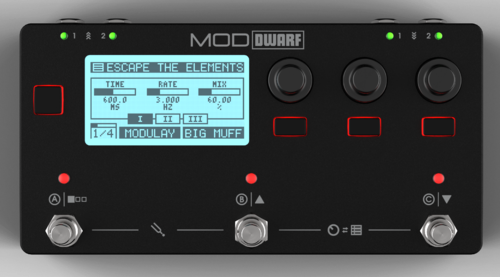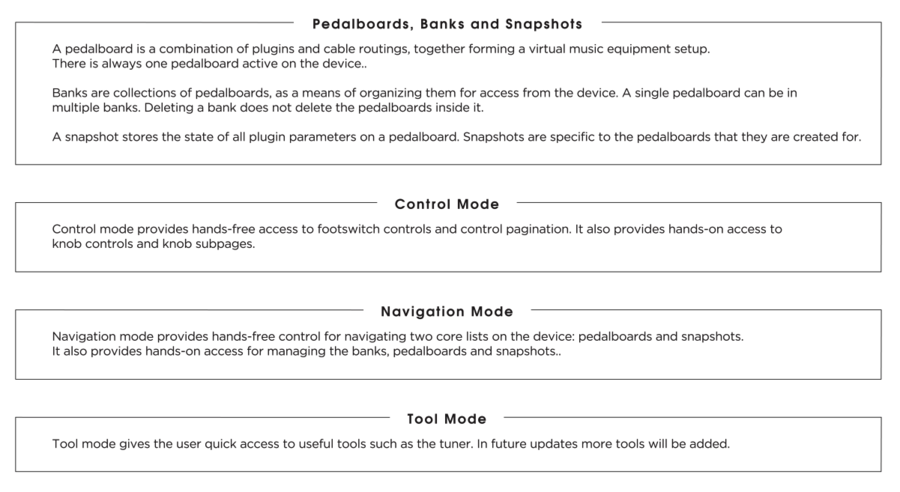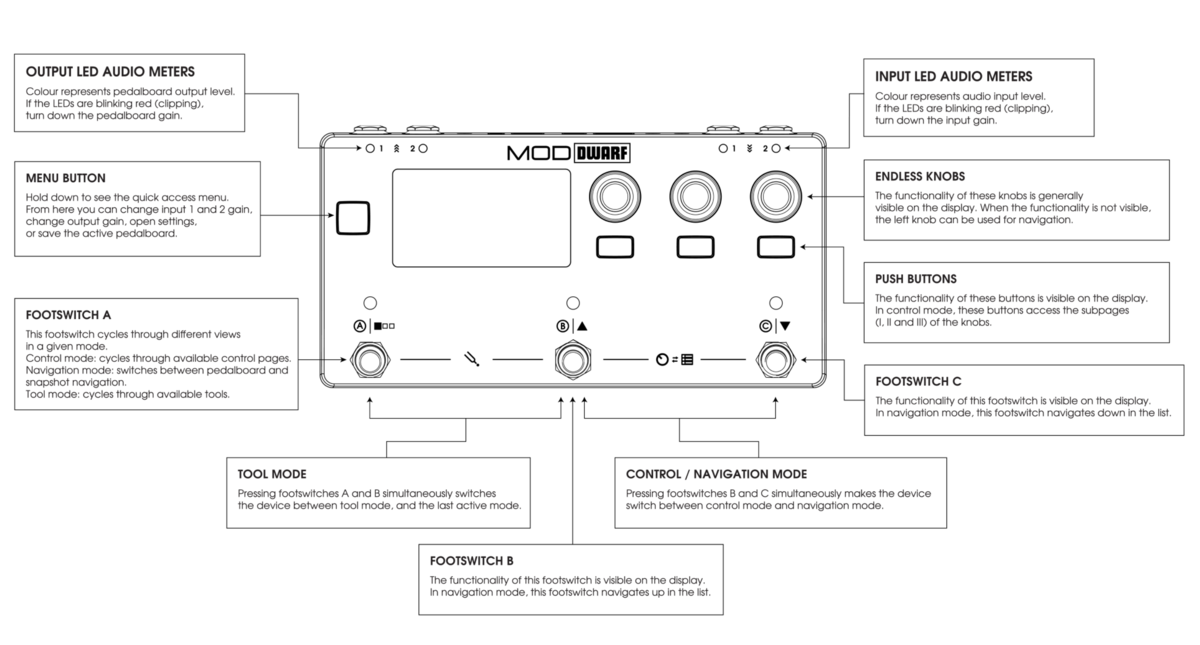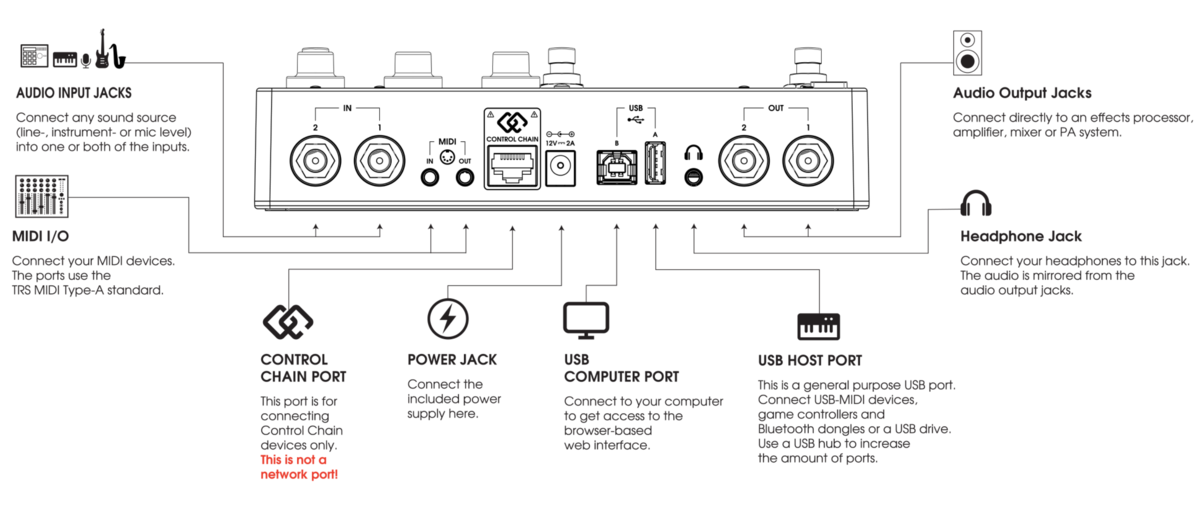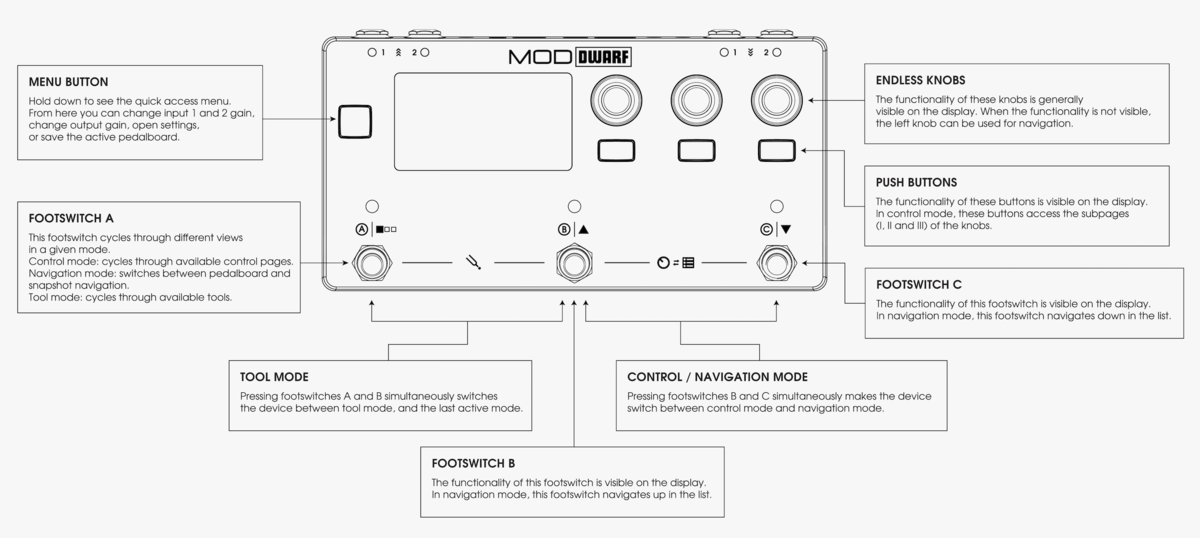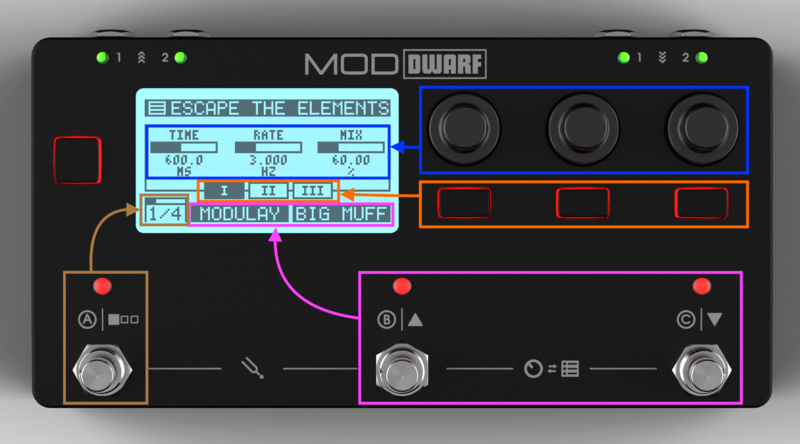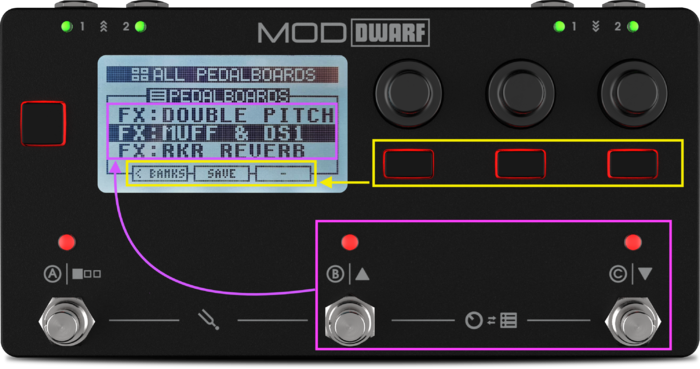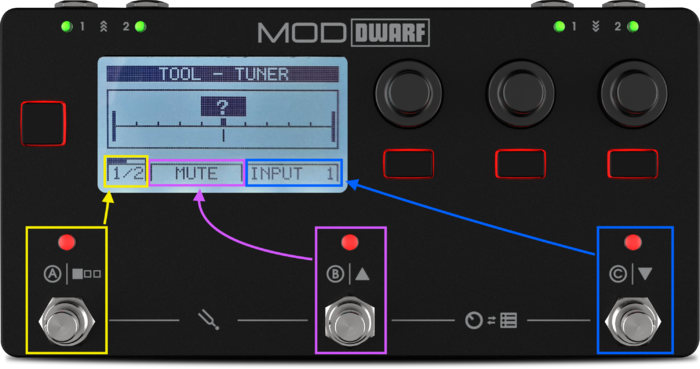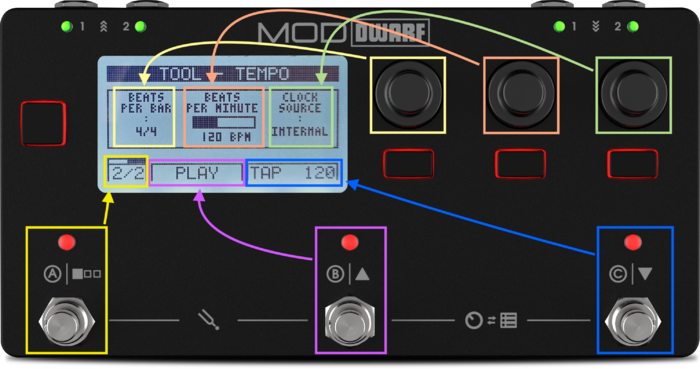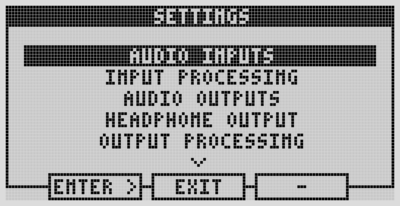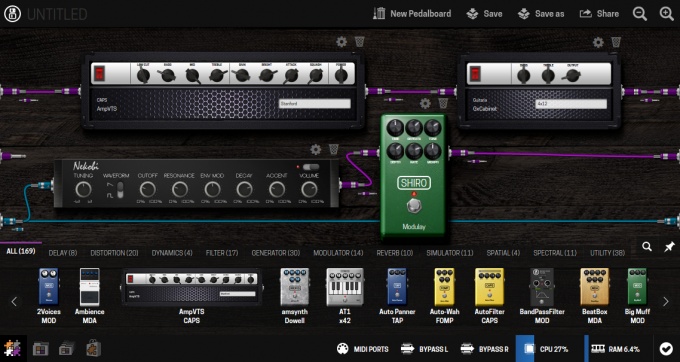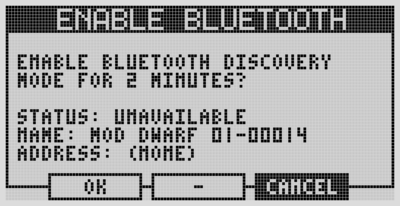Difference between revisions of "Dwarf User Guide"
| (107 intermediate revisions by 5 users not shown) | |||
| Line 7: | Line 7: | ||
* Do not expose the apparatus to rain, moisture, dripping or splashing and avoid placing objects filled with liquid, such as vases, on or near the apparatus. | * Do not expose the apparatus to rain, moisture, dripping or splashing and avoid placing objects filled with liquid, such as vases, on or near the apparatus. | ||
* Only use accessories approved by the manufacturer. | * Only use accessories approved by the manufacturer. | ||
| − | + | * Do not open the enclosure. There are no user repairable parts inside. Leave service and repairs to trained service personnel only. | |
'''AUDIO OUTPUTS WARNING !''' | '''AUDIO OUTPUTS WARNING !''' | ||
| − | + | * Always mute or turn down the volumes before connecting any equipment to the audio or headphone outputs. | |
| − | + | * The apparatus is capable of outputting loud signals via the audio and headphone outputs. These volume levels may damage your gear. Verify that the output volume is set to a level that your equipment can handle. | |
| − | + | * High volume levels may damage your hearing, please protect your hearing by paying attention to the output volume. | |
'''POWER ADAPTER WARNING !''' | '''POWER ADAPTER WARNING !''' | ||
| − | + | * The adapter may only be used indoors | |
| − | + | * To ensure adequate ventilation, do not place the power adapter in tight spaces. | |
| − | the power adapter in tight spaces. | + | * To prevent the risk of electric shock and fire because of overheating, please ensure that curtains and other objects do not prevent adapter ventilation. |
| − | + | * Use supplied adapter only | |
| + | |||
| + | =Concepts and Modes= | ||
| + | The concepts and modes of the MOD Dwarf are the explanation of the names and labels that we use to specify some MOD Dwarf features. | ||
| + | |||
| + | Having this in mind will help you better understand this user guide. | ||
| + | |||
| + | [[File:Concepts and Modes.png|900px]] | ||
=Overview= | =Overview= | ||
| Line 35: | Line 42: | ||
===Audio input jacks=== | ===Audio input jacks=== | ||
| − | The MOD Dwarf has two independent audio inputs, with configurable input gain for each input. You can set up the input gain through the device menu. | + | The MOD Dwarf has two independent audio inputs, with configurable input gain for each input. You can set up the input gain through the device menu. Check how to do it [[Dwarf_Device_Settings#Audio_Inputs|here]]. |
===Audio output jacks=== | ===Audio output jacks=== | ||
| − | The MOD Dwarf has two independent audio outputs, with configurable output gain for each output. You can set up the output gain through the device menu. | + | The MOD Dwarf has two independent audio outputs, with configurable output gain for each output. You can set up the output gain through the device menu. Check how to do it [[Dwarf_Device_Settings#Audio_Outputs|here]]. |
===Headphone=== | ===Headphone=== | ||
| − | The headphone output on the MOD Dwarf monitors outputs 1 and 2. It is possible to set the volume level of the headphone output through the device menu. | + | The headphone output on the MOD Dwarf monitors outputs 1 and 2. It is possible to set the volume level of the headphone output through the device menu. Check how to do it [[Dwarf_Device_Settings#Headphone_Output|here]]. |
===Power jack=== | ===Power jack=== | ||
| − | The MOD Dwarf comes with its own | + | The MOD Dwarf comes with its own power supply which outputs 12V, 2A over a center-positive barrel-type plug. |
| − | |||
| − | |||
The plug diameter of the power supply must be Φ5.5*2.1*10mm | The plug diameter of the power supply must be Φ5.5*2.1*10mm | ||
| − | |||
| − | |||
In summary, the power consumption of the MOD Dwarf varies depending on the peripherals connected to the device. For example: Hooking up a USB-hub to the USB-A port, and then hooking up multiple MIDI controllers to the hub will change the power requirements. | In summary, the power consumption of the MOD Dwarf varies depending on the peripherals connected to the device. For example: Hooking up a USB-hub to the USB-A port, and then hooking up multiple MIDI controllers to the hub will change the power requirements. | ||
'''By using the provided power supply you are sure that you will never run out of juice.''' | '''By using the provided power supply you are sure that you will never run out of juice.''' | ||
| − | |||
===Control Chain port=== | ===Control Chain port=== | ||
| − | MOD Control Chain devices (such as the | + | MOD Control Chain devices (such as the MOD Footswitch or the MOD Expression Pedal) have multiple benefits over MIDI Controllers. |
| − | MOD Control Chain devices have screens that show you on-demand what each of the footswitches or actuators is assigned to control. | + | MOD Control Chain devices have screens that show you on-demand what each of the footswitches (or other actuators) is assigned to control. |
You can daisy chain up to 8 Control Chain devices (this was the maximum we tested) using a single cable from one Control Chain device to the other. | You can daisy chain up to 8 Control Chain devices (this was the maximum we tested) using a single cable from one Control Chain device to the other. | ||
| − | MOD Control Chain devices use an open protocol, which means that you and all of our community can contribute to improving it. You can also use the [ | + | MOD Control Chain devices use an open protocol, which means that you and all of our community can contribute to improving it. You can also use the [[MOD Arduino Shield|Arduino Shield]] and build your own Control Chain device. |
Last but not least, Control Chain devices also allow you to have more resolution from your actuators than the current MIDI Controllers. | Last but not least, Control Chain devices also allow you to have more resolution from your actuators than the current MIDI Controllers. | ||
| Line 72: | Line 74: | ||
===USB Host port (USB port A)=== | ===USB Host port (USB port A)=== | ||
| − | In the most common scenario, this port is used to hook up a single USB-MIDI device, such as a MIDI | + | In the most common scenario, this port is used to hook up a single USB-MIDI device, such as a MIDI keyboard to control generator plugins. |
Another common scenario is using this port to hook up a Bluetooth dongle for wireless connection to your PC. | Another common scenario is using this port to hook up a Bluetooth dongle for wireless connection to your PC. | ||
| − | + | ||
| + | '''Applications:''' USB MIDI Host, USB Bluetooth dongle ([[Dwarf_Device_Settings#Bluetooth| for Bluetooth connection to the WebGUI]]), USB Flashdrive ([[MOD_Web_GUI_User_Guide#Backup_.26_Restore|making device backups]]) | ||
===USB computer port (USB port B)=== | ===USB computer port (USB port B)=== | ||
| − | This port is mostly used to connect the MOD Dwarf to your PC for setting it up. When executing a manual system update, its use changes to a mass-storage device, so that you can copy the update | + | This port is mostly used to connect the MOD Dwarf to your PC for setting it up. |
| + | |||
| + | When executing a manual system update, its use changes to a mass-storage device, so that you can copy the update file to the MOD Dwarf. | ||
| − | === | + | '''Applications:''' USB Ethernet (for [[MOD_Web_GUI_User_Guide|web interface]]), USB Mass Storage ([[Dwarf_Device_Settings#System_Upgrade|for upgrades]]), USB MIDI |
| − | The MOD Dwarf also supports "old-school" | + | |
| − | For that, the Dwarf uses two TRS 3.5mm ports | + | ===MIDI I/O=== |
| − | + | The MOD Dwarf also supports "old-school" MIDI devices. | |
| + | For that, the Dwarf uses two TRS 3.5mm ports. These can be directly connected to other devices using a 3.5mm TRS MIDI Type-A cable. | ||
| + | It is also possible to connect a dongle to convert it to DIN-MIDI. | ||
Make sure to use the right type of dongle! | Make sure to use the right type of dongle! | ||
| − | |||
==Actuators== | ==Actuators== | ||
| Line 93: | Line 99: | ||
===Endless knobs=== | ===Endless knobs=== | ||
| − | |||
| − | + | The endless knob click / hold down and turn modifies interaction with the knob function. | |
| − | + | For example: | |
| − | + | '''Example 1:'''on some parameters, you can push the endless knobs in order to access a full-screen view of the parameter and/or lists; | |
| − | |||
| − | + | '''Example 2:'''in navigation mode, you can click the knob to load the pedalboard, etc. | |
| − | + | On each of the knobs, you can have different parameter types: | |
| − | + | * '''Knob''': turn for precise value change, hold pressed and turn for coarse value change; | |
| + | * '''Trigger''': turn left, turn right or click to trigger; | ||
| + | * '''Toggle''': turn left for off, turn right for on, or click to toggle; | ||
| + | * '''List''': turn left to open list and select prev item, turn right to open list and select next item, click to open/close overlay, hold pressed then turn then release to open the list then change the value then immediately close the list. | ||
| − | === | + | ===Menu button=== |
| − | The | + | The Menu button is located on the left side of the display. |
| − | + | You can edit the Menu Items controllable from this menu in the [[Dwarf_Device_Settings#Menu_Items|Menu Items settings]]. | |
| − | + | (picture with close up of this button) | |
| − | == | + | ==Display== |
| − | + | The MOD Dwarf has a large (2.9") LCD display. The display normally gives dynamic information about the actions mapped to the device actuators, and is also used for displaying the device menus and tools. | |
| − | === | + | ===Control Mode=== |
| − | + | [[File:Dwarf_Display.png | 800px]] | |
| − | |||
| − | + | Each part of the display corresponds to one of the actuators. (See the image above) | |
| − | + | The top section of the display shows the Current Pedalboard or Snapshot name. You can define this in the Device Settings. | |
| − | + | The section below it shows the controls mapped to the endless knobs. | |
| − | |||
| − | The | + | The following section represents the three assignable pages for the endless knobs on the MOD Dwarf. |
| − | + | On the left of the bottom section, you can check the current actuators assignment page, while the two elements on its right show the name of the plugin parameter assigned to the footswitches B and C (correspondingly) according to the current assignment page. | |
| − | + | ==== Switching pages ==== | |
| − | The | + | The MOD Dwarf allows you to switch between 8 pages, each with 3 encoder subpages. This means that the 3 endless knobs on your Dwarf can be assigned up to 24 parameters each. The footswitches B and C can be assigned up to 8 parameters each. |
| − | + | To cycle between the main assignment pages, you can use footswitch A (long pressures cycle backwards). | |
| − | + | The 3 push buttons under the endless knobs provide access to the 3 encoder subpages for the active main page. | |
| − | + | (screenshots of assignment pages) | |
| − | |||
| − | |||
| − | |||
| − | == | + | ===Navigation Mode=== |
| + | [[File:MOD Dwarf_wiki_NavigationMode.png | 700px]] | ||
| − | + | Check the [[Dwarf_User_Guide#Actuators|Actuators]] chapter to learn how to access the Navigation Mode on your MOD Dwarf. | |
| − | + | The Navigation Mode is where you can view a list of the saved pedalboards in your MOD Dwarf and access each of them. | |
| − | |||
| − | |||
| − | |||
| − | |||
| − | + | On Navigation Mode you push Footswitch B to move up on the pedalboards list and Footswitch C to move down on the same list. By moving on the list you will also be loading new pedalboards. The pedalboard that appears with the arrow before the name is the pedalboard that you currently have loaded. | |
| − | + | By pushing Footswitch A you can access the list of snapshots saved on the selected pedalboard. You navigate this list using the Footswitch B and C and it works in everything as on the pedalboards list. | |
| − | - | + | You can also use the left-most endless knob to navigate both the pedalboards and the snapshots. Note that by using the endless knob to navigate these lists you can view the names of the saved pedalboards or snapshots and scroll through them without loading. Pushing the endless knob will load the selected pedalboard or snapshot. |
| − | + | On this mode, the left-most button allows you to move between the banks list and enter different pedalboards lists saved in your MOD Dwarf. | |
| − | + | Pushing the central button will allow you to save the current settings as the default settings of your loaded pedalboard. | |
| − | |||
| − | |||
| − | |||
| − | |||
| − | |||
| − | |||
| − | |||
| − | |||
| − | |||
| − | |||
| − | |||
| − | + | Note that the buttons have only assigned functions on the pedalboards list and on your banks list. Not on the snapshots lists. | |
| − | + | ===Tool Mode=== | |
| − | + | On the Tool Mode of the MOD Dwarf you have access to multiple tools. You can define the default one on the device settings, check [[Dwarf Device Settings|here]] how to do it. | |
| − | + | The default tool will be that one showcasing in the first place when you access your Tool Mode. Independently of your default tool, you can always scroll between all the tools by pushing the Footswitch A. | |
| − | + | The MOD Dwarf has currently available the following tools: | |
| − | + | ====Tuner==== | |
<div style="display:inline-block"> | <div style="display:inline-block"> | ||
{| | {| | ||
|- | |- | ||
| − | | [[File: | + | | [[File:MOD Dwarf_wiki_tuner.png | 700px]] |
|} | |} | ||
</div> | </div> | ||
| + | |||
| + | A built-in chromatic tuner. Both inputs can be used as the tuner input, to select between them push the right footswitch. | ||
| + | |||
| + | If you see a question mark on the tuner screen, it means the MOD Dwarf is not receiving any input or the input levels are too low. | ||
| + | |||
| + | By pushing the footswitch B you activate the mute feature. With the mute feature active when you access the Tuner tool your MOD Dwarf will mute. | ||
| + | |||
| + | ====Tempo==== | ||
<div style="display:inline-block"> | <div style="display:inline-block"> | ||
{| | {| | ||
|- | |- | ||
| − | | [[File: | + | | [[File:MOD Dwarf_wiki_tempo.png|700px]] |
|} | |} | ||
</div> | </div> | ||
| − | + | The MOD Dwarf has a built-in tool called "Tempo". This tool allows you to define the main tempo settings. | |
| − | + | On this tool, you can define the time signature (aka beats per bar), the BPMs (beats per minute), and the Clock Source on your device. | |
| − | + | By turning the left-most endless knob you will set the number of beats per bar. | |
| − | + | By turning the central endless knob you set the number of beats per minute. You can also use the tap tempo feature, for that you must tap the Footswitch C. Note also that the LED above the Footswitch C blinks according to your current BPM. | |
| − | + | Turning the right endless knob will scroll all the available options of Clock Source (Internal, MIDI, or Ableton Link). Note that when your clock source is MIDI the tap tempo is no longer available as indicated on the display on the Footswitch C area. Instead, you have a label informing you that it is Synced. | |
| − | + | On this tool, Footswitch B is assigned to start and stop the host transport. This controls the main clock of the system. | |
| − | + | ==LED Audio meters== | |
| − | + | The input and output LEDs on the top of your MOD Dwarf have smooth transitions between colors. The LED colors represent the following input levels: | |
| − | + | *Off: below -40dB | |
| − | + | *Green fade in: between -40dB and -6dB | |
| − | + | *Green fully ON, fading in yellow: between -6dB and -1dB | |
| − | + | *Red: between -1dB and 0dB | |
| − | + | *Blinking strong red: 0dB (CLIPPING!) | |
| − | |||
| − | |||
| − | |||
| − | |||
| − | |||
| − | * | ||
| − | |||
| − | |||
| − | |||
| − | |||
| − | |||
| − | |||
| + | <!-- =Dwarf gain staging= | ||
| + | (diagram of gain staging on the Dwarf) --> | ||
=Device Settings= | =Device Settings= | ||
| − | Pressing | + | Pressing Menu Button followed by the middle button will open the Device Settings menu. |
| − | Access the [[Device Settings]] page to learn how to use it to | + | Access the [[Dwarf_Device_Settings|Device Settings]] page to learn how to use it to adjust volumes and MIDI Settings, manage User profiles, and more. |
| − | [[File: | + | <div style="display:inline-block"> |
| + | {| | ||
| + | |- | ||
| + | | [[File:Dwarf_SettingsMenu.png | 400px]] | ||
| + | |} | ||
| + | </div> | ||
=Editing= | =Editing= | ||
| Line 248: | Line 239: | ||
==Accessing the graphical interface== | ==Accessing the graphical interface== | ||
| − | The MOD | + | The MOD Dwarf has a built-in graphical user interface (GUI), which means you don’t need to download any extra software in order to configure the device. To access the interface, you only need a web browser, such as Chrome, Safari, or Firefox. |
Once you are connected to your device you will be able to build and share your pedalboards, download new plugins, organize your banks for offline access and much more. | Once you are connected to your device you will be able to build and share your pedalboards, download new plugins, organize your banks for offline access and much more. | ||
| Line 258: | Line 249: | ||
==Accessing via USB cable== | ==Accessing via USB cable== | ||
| − | The easiest way to access the GUI is through the USB cable. Simply connect the USB cable, which you received along with your MOD | + | The easiest way to access the GUI is through the USB cable. Simply connect the USB cable, which you received along with your MOD Dwarf, to your PC or Mac. The operating system should recognize the MOD Dwarf as a network device and configure it automatically. However, this process may fail in certain Windows versions, if that is your case please check the [[Troubleshooting|troubleshooting page]] |
| − | After successfully connecting the MOD | + | After successfully connecting the MOD Dwarf to your PC or Mac, open your favorite browser and navigate to http://moddwarf.local/ (or http://192.168.51.1). |
==Accessing via Bluetooth== | ==Accessing via Bluetooth== | ||
| Line 266: | Line 257: | ||
It is also possible to connect to your computer using a wireless Bluetooth connection. Check [[Bluetooth|this page]] to see how to do it! | It is also possible to connect to your computer using a wireless Bluetooth connection. Check [[Bluetooth|this page]] to see how to do it! | ||
| − | [[File: | + | <div style="display:inline-block"> |
| + | {| | ||
| + | |- | ||
| + | | [[File:Dwarf_BluetoothMenu.png | 400px]] | ||
| + | |} | ||
| + | </div> | ||
Latest revision as of 14:41, 31 October 2024
Contents
Warnings
RISK OF FIRE, ELECTRICAL SHOCK OR PRODUCT DAMAGE
- Do not expose the apparatus to rain, moisture, dripping or splashing and avoid placing objects filled with liquid, such as vases, on or near the apparatus.
- Only use accessories approved by the manufacturer.
- Do not open the enclosure. There are no user repairable parts inside. Leave service and repairs to trained service personnel only.
AUDIO OUTPUTS WARNING !
- Always mute or turn down the volumes before connecting any equipment to the audio or headphone outputs.
- The apparatus is capable of outputting loud signals via the audio and headphone outputs. These volume levels may damage your gear. Verify that the output volume is set to a level that your equipment can handle.
- High volume levels may damage your hearing, please protect your hearing by paying attention to the output volume.
POWER ADAPTER WARNING !
- The adapter may only be used indoors
- To ensure adequate ventilation, do not place the power adapter in tight spaces.
- To prevent the risk of electric shock and fire because of overheating, please ensure that curtains and other objects do not prevent adapter ventilation.
- Use supplied adapter only
Concepts and Modes
The concepts and modes of the MOD Dwarf are the explanation of the names and labels that we use to specify some MOD Dwarf features.
Having this in mind will help you better understand this user guide.
Overview
The wireframe images below expose the controls and inputs/outputs that the MOD Dwarf has.
Device features
Inputs and outputs
Audio input jacks
The MOD Dwarf has two independent audio inputs, with configurable input gain for each input. You can set up the input gain through the device menu. Check how to do it here.
Audio output jacks
The MOD Dwarf has two independent audio outputs, with configurable output gain for each output. You can set up the output gain through the device menu. Check how to do it here.
Headphone
The headphone output on the MOD Dwarf monitors outputs 1 and 2. It is possible to set the volume level of the headphone output through the device menu. Check how to do it here.
Power jack
The MOD Dwarf comes with its own power supply which outputs 12V, 2A over a center-positive barrel-type plug.
The plug diameter of the power supply must be Φ5.5*2.1*10mm
In summary, the power consumption of the MOD Dwarf varies depending on the peripherals connected to the device. For example: Hooking up a USB-hub to the USB-A port, and then hooking up multiple MIDI controllers to the hub will change the power requirements.
By using the provided power supply you are sure that you will never run out of juice.
Control Chain port
MOD Control Chain devices (such as the MOD Footswitch or the MOD Expression Pedal) have multiple benefits over MIDI Controllers.
MOD Control Chain devices have screens that show you on-demand what each of the footswitches (or other actuators) is assigned to control.
You can daisy chain up to 8 Control Chain devices (this was the maximum we tested) using a single cable from one Control Chain device to the other.
MOD Control Chain devices use an open protocol, which means that you and all of our community can contribute to improving it. You can also use the Arduino Shield and build your own Control Chain device.
Last but not least, Control Chain devices also allow you to have more resolution from your actuators than the current MIDI Controllers.
NOTE: Please do NOT connect this port to a regular Ethernet port, it can damage your MOD Dwarf.
USB Host port (USB port A)
In the most common scenario, this port is used to hook up a single USB-MIDI device, such as a MIDI keyboard to control generator plugins.
Another common scenario is using this port to hook up a Bluetooth dongle for wireless connection to your PC.
Applications: USB MIDI Host, USB Bluetooth dongle ( for Bluetooth connection to the WebGUI), USB Flashdrive (making device backups)
USB computer port (USB port B)
This port is mostly used to connect the MOD Dwarf to your PC for setting it up.
When executing a manual system update, its use changes to a mass-storage device, so that you can copy the update file to the MOD Dwarf.
Applications: USB Ethernet (for web interface), USB Mass Storage (for upgrades), USB MIDI
MIDI I/O
The MOD Dwarf also supports "old-school" MIDI devices. For that, the Dwarf uses two TRS 3.5mm ports. These can be directly connected to other devices using a 3.5mm TRS MIDI Type-A cable. It is also possible to connect a dongle to convert it to DIN-MIDI. Make sure to use the right type of dongle!
Actuators
Endless knobs
The endless knob click / hold down and turn modifies interaction with the knob function.
For example:
Example 1:on some parameters, you can push the endless knobs in order to access a full-screen view of the parameter and/or lists;
Example 2:in navigation mode, you can click the knob to load the pedalboard, etc.
On each of the knobs, you can have different parameter types:
- Knob: turn for precise value change, hold pressed and turn for coarse value change;
- Trigger: turn left, turn right or click to trigger;
- Toggle: turn left for off, turn right for on, or click to toggle;
- List: turn left to open list and select prev item, turn right to open list and select next item, click to open/close overlay, hold pressed then turn then release to open the list then change the value then immediately close the list.
Menu button
The Menu button is located on the left side of the display.
You can edit the Menu Items controllable from this menu in the Menu Items settings. (picture with close up of this button)
Display
The MOD Dwarf has a large (2.9") LCD display. The display normally gives dynamic information about the actions mapped to the device actuators, and is also used for displaying the device menus and tools.
Control Mode
Each part of the display corresponds to one of the actuators. (See the image above)
The top section of the display shows the Current Pedalboard or Snapshot name. You can define this in the Device Settings.
The section below it shows the controls mapped to the endless knobs.
The following section represents the three assignable pages for the endless knobs on the MOD Dwarf.
On the left of the bottom section, you can check the current actuators assignment page, while the two elements on its right show the name of the plugin parameter assigned to the footswitches B and C (correspondingly) according to the current assignment page.
Switching pages
The MOD Dwarf allows you to switch between 8 pages, each with 3 encoder subpages. This means that the 3 endless knobs on your Dwarf can be assigned up to 24 parameters each. The footswitches B and C can be assigned up to 8 parameters each.
To cycle between the main assignment pages, you can use footswitch A (long pressures cycle backwards).
The 3 push buttons under the endless knobs provide access to the 3 encoder subpages for the active main page.
(screenshots of assignment pages)
Check the Actuators chapter to learn how to access the Navigation Mode on your MOD Dwarf.
The Navigation Mode is where you can view a list of the saved pedalboards in your MOD Dwarf and access each of them.
On Navigation Mode you push Footswitch B to move up on the pedalboards list and Footswitch C to move down on the same list. By moving on the list you will also be loading new pedalboards. The pedalboard that appears with the arrow before the name is the pedalboard that you currently have loaded.
By pushing Footswitch A you can access the list of snapshots saved on the selected pedalboard. You navigate this list using the Footswitch B and C and it works in everything as on the pedalboards list.
You can also use the left-most endless knob to navigate both the pedalboards and the snapshots. Note that by using the endless knob to navigate these lists you can view the names of the saved pedalboards or snapshots and scroll through them without loading. Pushing the endless knob will load the selected pedalboard or snapshot.
On this mode, the left-most button allows you to move between the banks list and enter different pedalboards lists saved in your MOD Dwarf.
Pushing the central button will allow you to save the current settings as the default settings of your loaded pedalboard.
Note that the buttons have only assigned functions on the pedalboards list and on your banks list. Not on the snapshots lists.
Tool Mode
On the Tool Mode of the MOD Dwarf you have access to multiple tools. You can define the default one on the device settings, check here how to do it.
The default tool will be that one showcasing in the first place when you access your Tool Mode. Independently of your default tool, you can always scroll between all the tools by pushing the Footswitch A.
The MOD Dwarf has currently available the following tools:
Tuner
A built-in chromatic tuner. Both inputs can be used as the tuner input, to select between them push the right footswitch.
If you see a question mark on the tuner screen, it means the MOD Dwarf is not receiving any input or the input levels are too low.
By pushing the footswitch B you activate the mute feature. With the mute feature active when you access the Tuner tool your MOD Dwarf will mute.
Tempo
The MOD Dwarf has a built-in tool called "Tempo". This tool allows you to define the main tempo settings.
On this tool, you can define the time signature (aka beats per bar), the BPMs (beats per minute), and the Clock Source on your device.
By turning the left-most endless knob you will set the number of beats per bar.
By turning the central endless knob you set the number of beats per minute. You can also use the tap tempo feature, for that you must tap the Footswitch C. Note also that the LED above the Footswitch C blinks according to your current BPM.
Turning the right endless knob will scroll all the available options of Clock Source (Internal, MIDI, or Ableton Link). Note that when your clock source is MIDI the tap tempo is no longer available as indicated on the display on the Footswitch C area. Instead, you have a label informing you that it is Synced.
On this tool, Footswitch B is assigned to start and stop the host transport. This controls the main clock of the system.
LED Audio meters
The input and output LEDs on the top of your MOD Dwarf have smooth transitions between colors. The LED colors represent the following input levels:
- Off: below -40dB
- Green fade in: between -40dB and -6dB
- Green fully ON, fading in yellow: between -6dB and -1dB
- Red: between -1dB and 0dB
- Blinking strong red: 0dB (CLIPPING!)
Device Settings
Pressing Menu Button followed by the middle button will open the Device Settings menu.
Access the Device Settings page to learn how to use it to adjust volumes and MIDI Settings, manage User profiles, and more.
Editing
Accessing the graphical interface
The MOD Dwarf has a built-in graphical user interface (GUI), which means you don’t need to download any extra software in order to configure the device. To access the interface, you only need a web browser, such as Chrome, Safari, or Firefox.
Once you are connected to your device you will be able to build and share your pedalboards, download new plugins, organize your banks for offline access and much more.
Please refer to the Web GUI User Guide to learn all about it.
Accessing via USB cable
The easiest way to access the GUI is through the USB cable. Simply connect the USB cable, which you received along with your MOD Dwarf, to your PC or Mac. The operating system should recognize the MOD Dwarf as a network device and configure it automatically. However, this process may fail in certain Windows versions, if that is your case please check the troubleshooting page
After successfully connecting the MOD Dwarf to your PC or Mac, open your favorite browser and navigate to http://moddwarf.local/ (or http://192.168.51.1).
Accessing via Bluetooth
It is also possible to connect to your computer using a wireless Bluetooth connection. Check this page to see how to do it!
